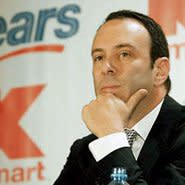One Chart Says Shows Why Sears (SHLD) Is Tanking
The fact that Sears Holdings Corp (NASDAQ:SHLD) is in trouble isn’t exactly a veiled secret. The once-iconic retailer has simply failed to remain relevant in the modern era of retailing, and SHLD shareholders have paid the price.


Amazon.com, Inc.
(NASDAQ:AMZN) gets the bulk of the credit for Sears failure, though not because it competes head-to-head with Sears in most product categories. Rather, the king of e-commerce reshaped how consumers think and feel about spending their money, teaching them to love online shopping with a wide variety of retailers.
Every company from Abercrombie & Fitch Co. (NYSE:ANF) to Zales not only benefited from the Amazon effect, but copied some of Amazon’s online success for themselves as they simultaneously reconfigured their brick and mortar presence to operate in the modern era. Every company except Sears, that is.
InvestorPlace - Stock Market News, Stock Advice & Trading Tips
At the same time Sears continually missed the brick and mortar boat by misunderstanding the current state of consumers, it consistently missed the mark online as well. The end result? A stunningly long streak of shrinking sales and wide losses.
And we do mean long.
If It Hasn’t Happened Yet…
As was noted, Sears—which also owns and operates K-Mart—has been losing ground for as long as most anyone can remember. Thing is, it’s actually been losing ground for longer than most people can remember.
How long? Since 2006, if you want to give credit for the growth the company achieved simply by acquiring the almost-defunct K-Mart chain 2005. As the chart below illustrates though, Sears’ struggle started in 2001, right around the time Amazon took flight and copycats started to follow.
SHLD shares have moved in tandem with Sears results, falling from a peak of $119 in 2007 to their current price near $7.
You could (almost) defend the 2001 and even the 2002 weakness on the recession we were in then. By 2003 though, all companies were back on their feet. Not Sears though. Sears was still losing ground, missing out altogether on the still-nascent e-commerce movement, but also missing out on the old-fashioned foot traffic that was still available to those venues willing and able to draw an actual, in-person crowd.
Yep, Sears has been moving in the wrong direction for sixteen years now.
It also hasn’t been profitable on a full-year basis since 2011. And, contrary to the message being delivered by hedge-fund-manager-turned-CEO Eddie Lampert, things aren’t turning around. They’re not even about to be turned around. They’re still getting worse.
For sixteen years they’ve been getting worse, with the last four of them under Lampert’s tutelage. He was largely in control as of 2004 though, becoming Chairman of the Board when K-Mart and Sears became one. It’s safe to say he’s not got a firm grip on what successful retailing looks like. If he did, we would have seen some semblance of success by now.
Sixteen years, the last thirteen of which with Lampert effectively in control. If it hasn’t happened yet, it’s just not going to.
Bottom Line for SHLD
The few remaining die-hard believers in Sears (presumably investors nursing steep losses on their SHLD trades) will be quick to point out that Sears recently inked a deal with Amazon to co-sell smart appliances. It’s a creative and interesting idea to be sure.
It’s also irrelevant though. Anything Sears can do on that front, rivals like Best Buy Co Inc (NYSE:BBY) and Home Depot Inc (NYSE:HD) can do better. Indeed, the initiative is just one of several dozen Sears has put into place recently, like curb-side pickup, a mobile shopping app, and the use of tablets as in-store sales tools were all ballyhooed, but none of them made a dent in the slow demolition of the retailer. That’s because none of them actually addressed the bigger problem. That is, Sears has alienated and disillusioned (and maybe never attracted in the first place) the bulk of its target market: a tech-savvy middle class that doesn’t want to be depressed if they do decide to shop in a store rather than online.
Just sell more stores or other pieces of itself to buy more time? Aside from the fact that there aren’t many valuable pieces left, each time that happens, the capacity to create much needed revenue is crimped. Lampert should be fixing what’s broken rather than selling what’s working.
Whatever the case, sixteen years is a long time. If nothing else, the company just has too much negative momentum to overcome now. SHLD may dish out the occasional glimmer of hope, but there is no turnaround story for the stock to latch onto here.
As of this writing, James Brumley did not hold a position in any of the aforementioned securities. You can follow him on Twitter.
More from InvestorPlace
The post One Chart Says Shows Why Sears (SHLD) Is Tanking appeared first on InvestorPlace.

